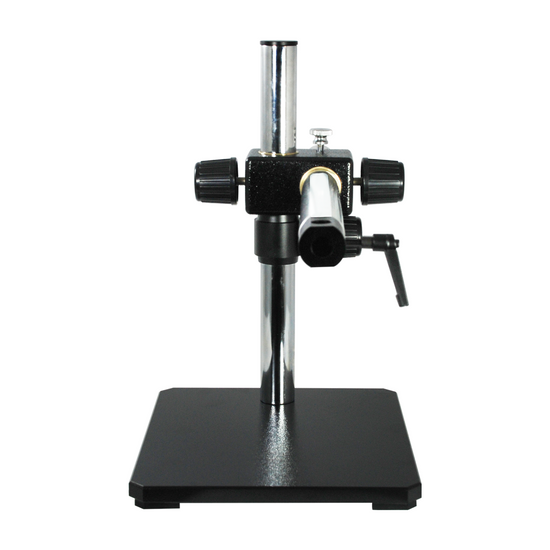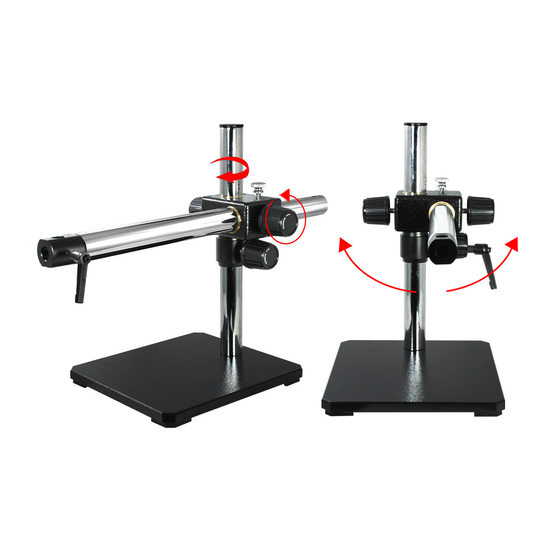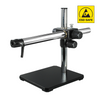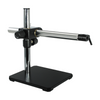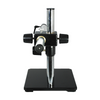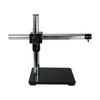Quick Overview
Boom Stand. Vertical Post Height: 380mm. Vertical Post Diameter: Dia. 37mm. Horizontal Arm Length: 544mm. Horizontal Diameter: Dia. 37mm. Mounting Hole on the Top of Horizontal Arm: 5/8 in. End Adapter. Base Dimensions: 285x260x15mm. ESD Safe.
ST19051431 ESD Boom Stand
Boom Stand
| Stand Type | Boom Stand |
| Vertical Post Height | 380mm |
| Maximum Vertical Post Extended Length | 254mm |
| Vertical Post Diameter | Dia. 37mm |
| Cross Adapter Type | Cross Hole Adapter |
| Horizontal Arm Type | Horizontal Post |
| Horizontal Arm Length | 544mm |
| Horizontal Diameter | Dia. 37mm |
| Mounting Hole on the Top of Horizontal Arm | 5/8 in. End Adapter |
| Horizontal Rotation Angle | 360° Degree Rotatable |
| Horizontal Arm Travel Distance on Z-Axis | 260mm |
| Horizontal Arm Stretch Range | 420mm |
| Horizontal Arm Maximum Load | 9.50kg (20.94lbs) |
| Horizontal Arm Travel Mode on Horizontal Direction | Manual |
| Horizontal Arm Travel Mode on Z Direction | Manual |
| Base Type | Heavy Duty Base |
| Base Shape | Rectangle |
| Base Dimensions | 285x260x15mm |
| Surface Treatment | Plastic Spray Coating |
| ESD Safe | ESD Safe |
| Material | Metal |
| Color | Black |
| Net Weight | 14.35kg (31.64lbs) |
| Dimensions | 544x285x405mm (21.417x11.220x15.945 in. ) |
Technical Info
Instructions
Microscope StandClose Λ
| Microscope stand have many options depending on the needs, especially stereo microscope stand, there are several factors to consider before choosing: Stability: microscope stand is used to prop up the microscope body. The stand should be selected according to the size of the microscope mainframe. The stability of the stand determines the stability of the microscope in use, and its various adapters and screws must be tightly locked. Volume size: limited by the working environment and space of the workbench. Workspace and scope: the size of the workspace of the object being observed and the height of the object being observed should be considered. Choice of lighting: some stands are equipped with a light source, but some are not, depending on whether there are conditions to add additional lighting. Operational requirements: 1. Install the stand as required. 2. Arrange a reasonable fixed position for the stand. 3. Carefully tighten the microscope mainframe. 4. Arrange the location of the additional light source reasonably, and place the electric wire in a position that does not interfere with the work. 5. Connect the various kinds of peripheral devices, such as cameras, monitors, computers and so on. |
Boom StandClose Λ
| Boom stand is also called universal stand. It is a relatively large pole type stand. The height and length of the stand are big, and it can be freely adjusted in height, length and various angles. Its large weight ensures stable support and occupation of large space, but it can make the microscope free to move in a wide range with convenience. Boom stand is suitable for observing large objects. The direction of boom stand is flexible, and when in use, various kinds of positions and methods can be adopted, such as front, side, and tilt etc., to facilitate the layout of the workbench. On the side of the crossbar of the boom stand, a 5/8-inch connecting hole is generally left for connecting various focusing mechanisms and microscopes. The base of the boom stand usually only plays a fixing and supporting role. Under the observation of the microscope, it is an empty workbench, which can be used to place various platforms, work operating surfaces, and tools, etc., and can be freely combined into different working positions. When the base is large, the object to be observed can also be placed. In industrial places, most of the working positions are fixed. Sometimes, in one working position, a lot of tools, equipment and instruments need to be placed.. Because the microscope is relatively large in size and takes up also a relatively bigger space, and not convenient to move back and forth, therefore for purpose of use, the boom stand can be placed in an appropriate position, and does not need to occupy the most commonly used work tables. When in use, the microscope can be moved over, and pushed to the side when not in use. This is very suitable for use in electronics factories, installation and maintenance, medical and animal anatomy, archaeology and other industries. Boom stand generally does not have a fixed focusing device, and you can choose a variety of flexible accessories. Because the stand needs to ensure flexibility, therefore there are many locking buttons in all directions. In any time after adjustment, it must be ensured that each knob is in a locked state to avoid sliding, tilting and flipping of the microscope, thereby damaging the microscope and the items on the workbench. |
360° Degree RotatableClose Λ
| The eyepiece of the microscope can have different viewing or observing directions. When the position of the microscope is uncomfortable, the direction of the eyepiece tube of the microscope can be adjusted, to facilitate observation and operation. Placement method of different viewing angles of the microscope: General direction: the support column is behind the object to be observed Reverse direction: the support column is in front of the object to be observed Lateral direction: the support column is on the side of the object to be observed Rotating eyepiece tube, different microscopes may have different methods, for some, the direction is confirmed when installing the eyepiece tube of the microscope, for some, by rotating the body of the microscope, and for some, by rotating the support member on the support or holder of the microscope. |
ESD SafeClose Λ
| Static electricity is a charge that is at static or non-flowing state, and static electricity is formed when charges accumulate on an object or surface. Static electricity can cause malfunction or mis-opeartion of electronic equipment, resulting in electromagnetic interference. In the electronics industry, static electricity can break down integrated circuits and precision electronic components, causing components to age, and can also absorb dust, causing contamination of integrated circuits and semiconductor components, and reducing production yield. In the plastics industry, static electricity can cause film or membrane not wining up uniformly, film and CD plastic discs contaminated with dust, thereby affecting quality. In industrial production, especially in electronic production and processing and inflammable and explosive production sites, electrostatic protection should be taken seriously. ESD means "electro-static discharge." For the methods of ESD treatment with respect to microscope and components, electrical conductivity of the metal should be utilized on the one hand, and on the other hand, electrostatic materials, electrostatic coating and other methods of treatment should be adopted to solve the electrostatic problem. Electrostatic coating is to apply coat that can prevent static electricity. It has electrostatic discharge, dust-proof, mildew-proof, wear-resistant, acid and alkali resistance and other characteristics. The surface of the coating does not generate static electricity or the static electricity is discharged to the safe place through the conductor row. On some components, electrostatic materials may be applied, such as the microscope knob handle, insulation mat, septum, microscope cover etc. |
PackagingClose Λ
| After unpacking, carefully inspect the various random accessories and parts in the package to avoid omissions. In order to save space and ensure safety of components, some components will be placed outside the inner packaging box, so be careful of their inspection. For special packaging, it is generally after opening the box, all packaging boxes, protective foam, plastic bags should be kept for a period of time. If there is a problem during the return period, you can return or exchange the original. After the return period (usually 10-30 days, according to the manufacturer’s Instruction of Terms of Service), these packaging boxes may be disposed of if there is no problem. |
| Packing | |
| Packaging Type | Carton Packaging |
| Packaging Material | Corrugated Carton |
| Packaging Dimensions(1) | 51x43x18cm (20x17x7″) |
| Inner Packing Material | Plastic Bag |
| Ancillary Packaging Materials | Expanded Polystyrene |
| Gross Weight | 15.95kg (35.16lbs) |
| Minimum Packaging Quantity | 1pc |
| Transportation Carton | Carton Packaging |
| Transportation Carton Material | Corrugated Carton |
| Transportation Carton Dimensions(1) | 51x43x18cm (20x17x7″) |
| Total Gross Weight of Transportation(kilogram) | 16.11 |
| Total Gross Weight of Transportation(pound) | 35.52 |



